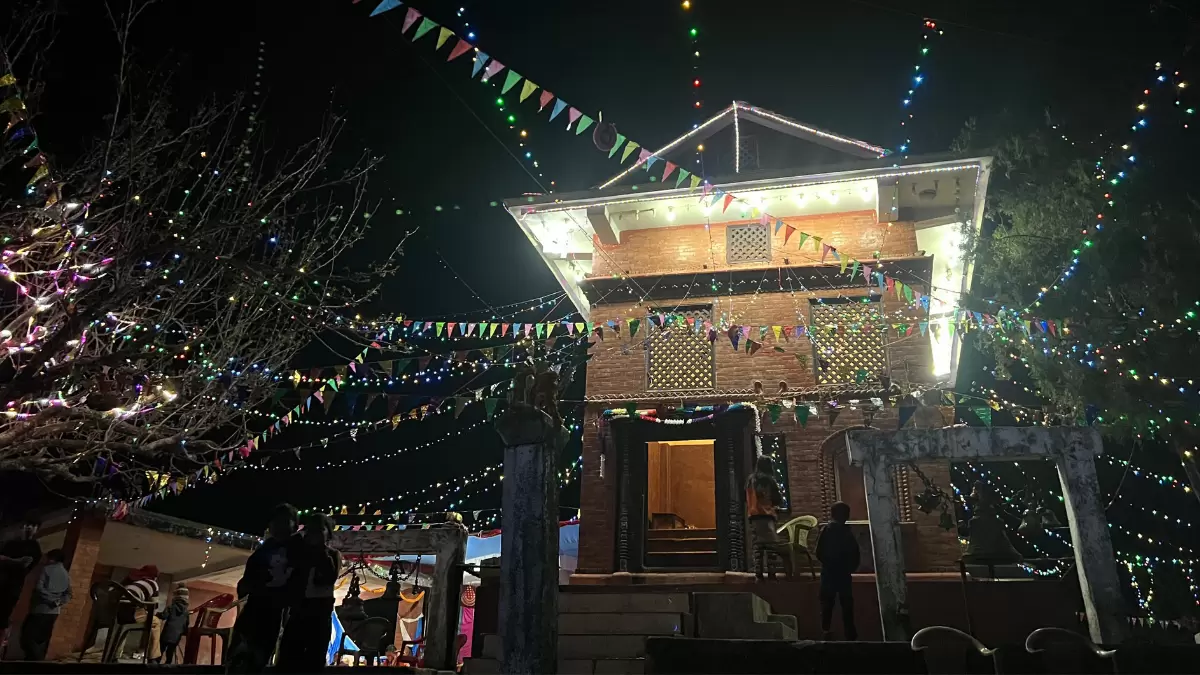The Salayan Kot Bhagawati temple is a significant Hindu shrine located in the Salayan Kot area of Dhading district, Nepal, dedicated to goddess Tripursundari. The Tripurasundari temple stands as a symbol of spiritual devotion, cultural richness, and architectural race. This temple’s historical significance, religious value, and breathtaking surroundings make it a must-visit destination for those interested in spirituality and heritage.
Cultural and Religious significance
The Tripurasundari Temple holds deep cultural and religious importance in the region. It is renowned for its annual festival, known as Tripurasundari Jatra, which takes place in the month of Mangsir (around November-December). During this festival, the idol of Goddess Tripurasundari is ceremoniously carried from the Salyan Kot temple to the Haase Bazaar temple in the Tripurasundari Rural Municipality-6. This procession is accompanied by traditional rituals, including the presence of devotees carrying Khukuri’s and other ceremonial items.
The temple is also associated with a unique tradition where the goddess’s idol is moved between different temples within the locality, symbolizing the deity’s visits to her maternal home and other place. Salyan Kot Bhagawati temple is a significant religious site, where the devotees are known to carry the goddess idol from the hilltop temple to the temple down in the valley.
Historical Background
According to local history, the temple was established approximately 450 years ago, as mentioned in the book Gorkha Ko Itihas by Dinesh Raj Pant. However, some accounts suggest that the temple was originally built over 1600 years ago by King Anshu Varma at the banks of the Netrawati River in Hanse (Thulo Bensi) Phant. The temple is situated in the midst of paddy fields, where the temple’s caretakers also engage in agriculture activities as part of their service to the goddess.
Visiting the Temple
The Tripurasundari temple is accessible from Dhadingbesi, with a journey towards northwest, and the area is known for its scenic beauty, and visitors can experience the rich cultural heritage of the region during the festival season. If you are planning to visit, it is advisable to check the local festival calendar, as the Tripurasundari Jatra is a major event that attracts numerous devotees and visitors each year. There are three different temples where the goddess is kept in this temple on different occasions of the year.
Tripurasundari Temple Consecration Program
Location: Salyan Kot, Dhading, Nepal
Dates: November 11 to 16, 2024
Deity: Tripurasundari Bhagawati (Salyan Kot Bhagawati)
Theme: Divine Grace and Cultural Unity
The Tripurasundari temple is a significant Hindu shrine located at the Salayan Kot area of Dhading district, Nepal, dedicated to goddess Tripurasundari. On November 2024, Kailash Foundation has organized a consecration program at Tripurasunadri temple, in the remote Himalayan region of Dhading. The Kailash Foundation has organized a five-day consecration program at Salayan Kot Bhagawati temple where thousands of pilgrims take part. The main aim of this consecration program is to involve a ceremony or ritual to signify the dedication towards the goddess.
On November 10, 2024, the team member of Kailash Foundation and the priest (Pandits or Purohits) went to Salyan Kot from Kathmandu.
November 11: Poorva Karma and preparation
Morning
- Ganesh Puja (to remove obstacle)
- Sankalpam (formal intention)
- Cleaning and purification of temple premises
Afternoon
- Kalash Sthapana (installation of holy pots)
- Agni Pratishta (establishing the sacred fire)
Evening
- Bhajans and Devi Stotra Chanting
- Community orientation and parshad distribution
November 12: Navagraha and Vastu Puja
Morning
- Navagraha Shanti Homam (for planetary peace)
- Vastu Puja (honoring temple space and directions)
Afternoon
- Homams for Lakshmi, Saraswati, and Durga
Evening
- Cultural performances by local people (Nepali folk song / dance)
- Lighting of 108 Lamps around the temple
November 13: Maha Rudra and Devi Homam
Morning
- Rudra Abhishekam
- Tripurasundari Moola Mantra Homam
Afternoon
- Community Yajna participation
- Chandi Path (chanting Durga Saptashati)
Evening
- Spiritual discourse on Tripurasundari
- Group Bhajan and Kirtan night
November 14: Prana Pratishtha day
Morning (main Prana Pratishtha Rituals)
- Netronmilana (opening the divine eyes)
- Murti Abhisheka (ritual bathing)
- Prana Pratishta Mantras and invocation
Afternoon
- Maha Aarti and Darshan
- Distribution of MahaPrasadam
Evening
- Traditional dance
- Fireworks and celebration
November 15: Community celebration
Morning
- Devotee darshan and group puja
- Vedic chanting by locals priests
Afternoon
- Annapurna Bhojan (mass feeding)
- Honoring donors, volunteers, and priests
Evening
- Satsang and Devi Bhajan Sandhya
November 16: Purnahuti and closure
Morning
- Final Homas and Purnahuti (conclusion of year)
- Kalasha Visarjan (immersion of sacred pots)
Afternoon
- Blessing from senior priests and elders
- Final darshan and closing Aarati
Evening
- Gratitude ceremony for all contributors
- Cultural finale and closing announcements

